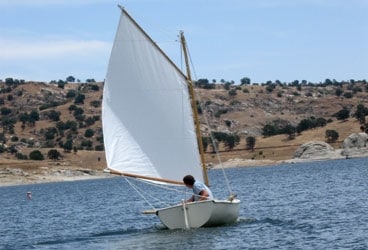
Minimede 368
Sketching carefully on a piece of square-ruled paper, I muttered, “Codfish bows and a mackerel tail.”
“What’s that, dear?” asked my wife, Danielle, who’d just wandered into the kitchen with a child on her hip.
I looked up. “I’m designing a dinghy to go on the cabin top.”
“Isn’t it a bit soon?” she asked. “I mean, we’ve only just put the cabin top on.”
“I know. But I want to design our dinghy to make sure everything fits. I don’t want it to interfere with the staysail sheets or the companionway or the stovepipe.”
“What’s a ‘mackerel tail’?”
“I think it means long and skinny, like the aft end of a mackerel just kind of tapers away to the tail. I read once-don’t remember where-that to make a boat seakindly, you should give it broad bows like a codfish and a skinny tail like a mackerel.”
“Sort of like Ganymede has.”
“Right. I’m sort of trying to draw a mini Ganymede here.”
“A Minimede?” she said with a grin.
The drawing didn’t take long; there’s not much you can do with a dinghy once you’ve filled out the basic length, beam, and depth requirements. Then it was time to build a prototype. Having built prototypes for a couple of different dinghies in the past, I knew two ways not to do it: papier-mâché over chicken wire, and stitch-and-glue plywood. The latter method isn’t so bad, but plywood-formed boats inevitably have chines, and I wanted a fair hull without angles.
My method this time was to cut plywood cross-sections every 18 inches or so, marking the curves with a batten, and screw them keel up to a workbench, with spacers between to keep them parallel. That gave me solid ribs to which I could fasten planking.
After a false start with redwood battens, I tried planking it with flat baseboard strips made out of dense pressed cardboard. They took the curve pretty easily and held tight with panel nails. After only a few days, it looked like someone had left a little wooden boat sitting upside down next to our shop.
My friend John Worden is a drywall finisher who’d recently helped me fair the topsides of our Cape George 31 cutter. Fairing a dinghy is child’s play for him, especially since we used drywall mud instead of smelly vinylester fairing compound. After Danielle, our daughter Antigone, and I had filled in all the gaps with plaster and sculpted a square stemhead, John came over with his 16-inch fairing knives and made short work of smoothing the hull.
After the plaster and later a coat of paint had thoroughly dried, I had what fiberglass workers call a “plug”: a full-scale model of the finished product over which to make a mold. The rest was now-familiar ground. After building decks and a cabin top for a 31-foot boat, glassing over a nine-foot dinghy plug didn’t seem to take very long.
Once the plug was removed and the mold buffed out on the inside, we built three dinghies. The first was a test model to see how it would fit and how it would sail, row, and carry cargo. The second hull was a dud-it had so many blemishes that they weren’t worth fixing, so we set it aside and very carefully built a third. That one came out perfect-strong, light, and roomy-and with the data gathered using the test model, it possessed sufficient flotation to keep it floating if swamped and had the mast partner and oarlocks in their proper places. We later sold the test model on craigslist.
Before we’ve even sailed the big boat, our new little tender, with its broad bows and tapering tail, has given us hours of exploring and sailing satisfaction. These remind us what it’s like to be on the water and provide a taste of the places Ganymede will go with a little homemade tender safely stowed upside down on the coach roof.
Ben Zartman, who reports on his progress every other month, is coming to the end of his to-do list on Ganymede (and Minimede).








